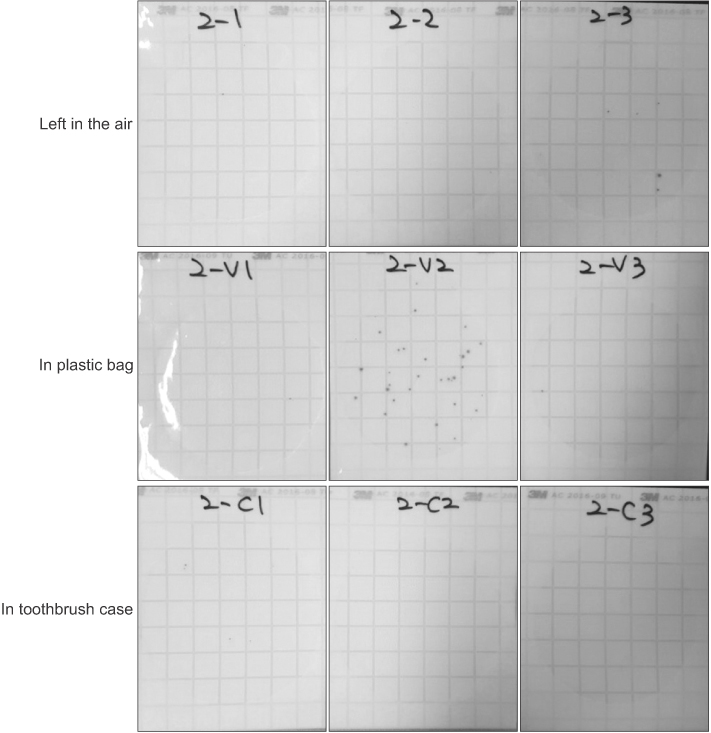J Korean Acad Oral Health.
2017 Dec;41(4):250-254. 10.11149/jkaoh.2017.41.4.250.
A comparative analysis of micro-organism colonization of tooth-brushes in a public bath based on the storage technique
- Affiliations
-
- 1Department of Biomedical Health Science, Graduate School, Dong-Eui University, Busan, Korea.
- 2Department of Preventive & Community Dentistry, Pusan National University, Yangsan, Korea.
- 3Department of Dental Hygiene, College of Nursing, Healthcare Sciences & Human Ecology, Dong-Eui University, Busan, Korea. yamako93@deu.ac.kr
- KMID: 2400240
- DOI: http://doi.org/10.11149/jkaoh.2017.41.4.250
Abstract
OBJECTIVES
Bacterial colonization on toothbrushes can cause stomatitis and other oral diseases such as dental caries and periodontitis. In this study we tested 18 toothbrushes, of which six were left exposedto the air, six were stored in a plastic bag, and six in a toothbrush case.
METHODS
ATP (RLU: relatively light unit) values measured by ATP Luminometer were compared with APC (CFU: colony forming unit) by swabbing culture method using 3Mâ„¢ petrifilmâ„¢ aerobic count plates.
RESULTS
Swabs from toothbrushes left exposed in the air developed an average of 651.67±261.94 CFU, while the "In plastic bag" and the "In toothbrush case" specimens developed 593.17±354.33 and 120.83±68.87 CFU, respectively.
CONCLUSION
The best option is to rinse the toothbrush well with water and to keep them dry in a well-ventilated area in order to reduce the growth of bacteria in a public bath.
Keyword
MeSH Terms
Figure
Reference
-
1. Cho PK, Park SS. Study on the O'Leary index and dental plague index of dental patients. J Korean Soc Dent Hyg. 2009; 9:426–438.2. Hong SJ, Lee SD, Bae JS. Reduction of plaque and gingival leeding by toothbrushing deucation and scaling. J Korean Acad Dent Health. 1994; 18:434–439.3. Yoon SU, Yang WH. PHP index according to toothbrushing behavior and smoke status of some local residents. J Korean Soc Dent Hyg. 2013; 13:261–269.
Article4. Kang HK, Kim KK. Periodontology. 3rd ed. Seoul: Komoonsa;2007. p. 101–104.5. Jeong YK, Seong YR, Cho KS, Seong HK, Kim JB. Bacteriological contamination of home toothbrushes and hygiene improvement. J Korean Acad Dent Health. 1992; 16:15–17.6. Kim JS, Kim JB. Prevalence and toxin genes of food-borne pathogens isolated from toothbrush in child care center. J Food Hyg Saf. 2015; 30:242–248.
Article7. Chong MS, Moon IK. Contamination of isolated microorganisms from the toothbrushes according to storage. J Korean Health Fundam Med Sci. 2016; 9:44–50.8. Song WH, Choi SG, Yang BS, Lee JS. Detection of waterborne pathogens in public bath houses by PCR-reverse blot hybridization assay (PCR-REBA). J Korea Acad Ind Coop Soc. 2011; 12:3517–3522.
Article9. Jawetz W, Melnick JL, Adelberg EA, Brooks GF, Butel JS, Ornston LN. Medical Microbiology. 18th ed. Norwalk, Connecticut/SanMateo: Appleton & Lange;1989. p. 215–217.10. Lee MO. Bacteriological contamination of toothbrushes by dental plaque acidogenicity and related behaviors to toothbrush use. J Korean Soc Dent Hyg. 2004; 4:255–263.11. Ahn SH, Lee MR, Lee YJ, Chun JA. Septic environment of dental clinics in korea. Int J Clin Prev Dent. 2010; 6:15–23.12. Ji EH, Shin WY, Kwon HJ. Evaluation of Cross Infection control program using adenosine tri phosphate (ATP) test in dental environment. Int J Clin Prev Dent. 2011; 7:19–24.13. Whiley RA, Beighton D. Curent classification of the oral streptococci. Oral Microbiol Immunol. 1998; 13:195–216.14. Griffiths MW. Applications of bioluminoscence in the dairy industry. J Dairy Sci. 1993; 76:3118–3125.15. Kim YS, Moon HK, Kang SI, Nam EJ. Verification of the Suitability of the ATP Luminometer as the monitoring tool for surface hygiene in foodservices. J Korean Soc Food Sci Nutr. 2010; 39:1719–1723.
Article
- Full Text Links
- Actions
-
Cited
- CITED
-
- Close
- Share
- Similar articles
-
- An Improved Brushculture Method in Tinea Capitis
- Micro-CT analysis of volumetric change of calcium silicate-based root-end filling materials
- Fecal Microbiota Transplantation against Gut Colonization Using a Multidrug-Resistant Organism
- Evaluation of the periodontal and pulpal healing of replanted rat molars with doxycycline root conditioning
- Comparative evaluation of micro-shear bond strength between two different luting methods of resin cement to dentin



